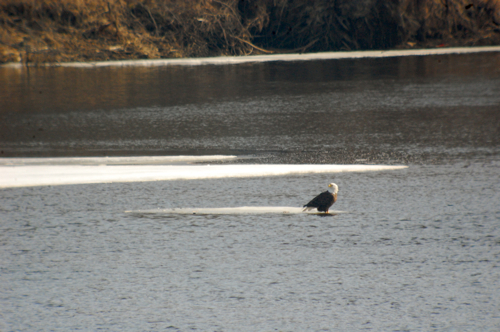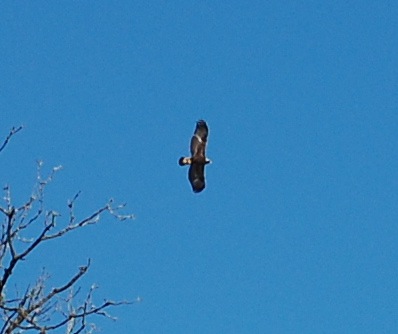If anyone is in driving distance of The National Eagle Center wants to play with the new Swarovski ATX spotting scopes or try out some digiscoping, I will be hanging out at the Big River Optics booth this Saturday and Sunday (March 16 and 17) from 10am - 4pm. We can practice with a smartphone or SLR. You can even try my Nikon V1. The center has a ton of fun things on tap this weekend, so you can really make a day of it. Also, I highly recommend including a stop right across the river from Wabasha to the Nelson Creamery for some cheesy goodness.

Speaking of The National Eagle Center, I had the privilege of doing a ranger program before Scott Mehus from the National Eagle Center went on. This was a real treat for me, he is a master at giving programs to kids and all audience ages. When you see a pro at work, even if you already know the information they are going to present, it's a pleasure to watch them in action. If you ever see Scott advertised for your local bird club, even if you think eagles aren't your thing--go. I bet he could even make accounting interesting! You can also meet him at the National Eagle Center too. A great guy...who not only knows his way around a bird of prey, but also makes some very tasty cookies (his wife is a lucky lady).
So of course after my program, I had to do some digiscoping. Colvill Park in Red Wing, Minnesota is a well know spot for watching eagles from November through March. Though, with the nests in the area, you can see them any time, the eagle numbers are simply larger in winter.
There generally seems to be one adult bald eagle that perches regularly in the park itself, sometimes right over the well used trail along the river. I was digiscoping that bird (as were several photographers) and it seemed completely oblivious. It didn't pay us any mind. As I looked through my scope, I noticed a crack in its beak. I wondered if it flew into something at some point or if it had an altercation with another bald eagle over territory. It certainly didn't perch near the other bald eagles along the river.
As I was taking photos, the bird would look around and I noticed that on the other side of its face, they eye didn't look good. Let's take a closer look:
That doesn't look like a functional eye. Then I remembered an eagle that Non Birding Bill and I saw in Colvill Park a few winters earlier. When I came home, I dug through my photo archive:
I took this photo on January 17, 2011. I wonder if it is the same bird? I don't have any shots of the other side of the beak to see the crack, but the eye looks similar and this was a bird you could get fairly close to in the park:
I'm willing to bet money that this is the same bird. There's plenty of easy food opportunities around Red Wing for an eagle that is not at the top of its game. If this is the same bird, it was an adult in this photo from 2011--so at least 5 years old. I took a photo two winters later, making it at least 7, but when I took the original photo, it could have already been 10 years old. It's tough to say.
I'm always amazed by a bird's resiliency. Many wildlife rehab centers wouldn't release a bird with one eye. The bird could become an education bird or in some cases, euthanized. But more and more, I see examples of birds that appear to do well and even thrive with one eye, here's at least one red-tail that I've talked about and you have you read about Julie Zickefoose's titmouse she calls Scarface that most likely survived an accipiter attack? Here's the initial photo...and here it is over a month later.
So, if you are in the Twin Cities, maybe make a day of it. Drive down to Red Wing's Colvill Park and see if you can find this eagle, then head a bit further south to the National Eagle Center in Wabasha and say hi to me...and don't forget Nelson for some tasty, tasty cheese.






 Can you tell the difference between these 2 birds? If not, you should consider coming to the
Can you tell the difference between these 2 birds? If not, you should consider coming to the 
 About 10 eagles crowded around a carcass. Observed during one of my many bird surveys this fall. This was digiscoped close to dawn.
About 10 eagles crowded around a carcass. Observed during one of my many bird surveys this fall. This was digiscoped close to dawn.








 An adult bald eagle rides an ice flow down the melting Mississippi River.
An adult bald eagle rides an ice flow down the melting Mississippi River. I spent the weekend at
I spent the weekend at 








 Last week I joined
Last week I joined 

 The forceps in the above photo are holding together the straps before Mark sews them together. They have to make sure the straps are snug enough to not fall loose and inhibit the eagle's movements but also loose enough to accommodate a bird's fluctuating weight. A hood is placed over the eagle's head to help keep her calm and to also allow Mark to work in peace without the eagle waving her hooked beak around near chest. It helps the process go along faster and safer for the eagle.
The forceps in the above photo are holding together the straps before Mark sews them together. They have to make sure the straps are snug enough to not fall loose and inhibit the eagle's movements but also loose enough to accommodate a bird's fluctuating weight. A hood is placed over the eagle's head to help keep her calm and to also allow Mark to work in peace without the eagle waving her hooked beak around near chest. It helps the process go along faster and safer for the eagle.
 The terrified man, shown here protected by his faithful hound, was "simply glad to have survived the encounter."
The terrified man, shown here protected by his faithful hound, was "simply glad to have survived the encounter." Here he indicates where the savage attack took place... right outside his own window!
Here he indicates where the savage attack took place... right outside his own window! Your faithful reporter thought he meant here. Turns out that was your faithful reporter's own bootprint.
Your faithful reporter thought he meant here. Turns out that was your faithful reporter's own bootprint. Turns out he meant here. Imagine the event, if you will. In fact, you sorta have to.
Turns out he meant here. Imagine the event, if you will. In fact, you sorta have to. Here the witness looks at the tree into which the bird flew, following the attack.
Here the witness looks at the tree into which the bird flew, following the attack. Pictured: the tree into which the Eagle may have flown. Not pictured: the Eagle.
Pictured: the tree into which the Eagle may have flown. Not pictured: the Eagle. Your faithful reporter scans the skies for sight of the fell beast. What's that? Has the eagle returned, red in tooth and claw?
Your faithful reporter scans the skies for sight of the fell beast. What's that? Has the eagle returned, red in tooth and claw? No. Just some bees. Strangely out and about in sub-zero weather, they quickly proved more than a match for this humble correspondent, who beat cheeks after rescuing one or two from a snowy grave.
No. Just some bees. Strangely out and about in sub-zero weather, they quickly proved more than a match for this humble correspondent, who beat cheeks after rescuing one or two from a snowy grave.














